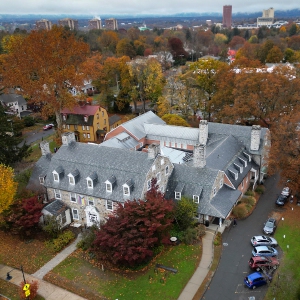Amherst planners seek ways to increase housing density
| Published: 03-02-2023 9:18 PM |
AMHERST — Several mixed-use buildings featuring numerous apartments have opened or are being built throughout Amherst, a construction trend that is not abating even as a required street level retail component is not always immediately filled.
“Right now, the residential market is so strong that it can subsidize the commercial space, so developers have said they are willing to have their commercial space sit vacant for five years, knowing they can get top dollar for the residential spaces,” Senior Planner Nate Malloy told the Planning Board this week.
Amherst continues to face a short supply of housing that is also very expensive, for both buyers and renters, trends that municipal officials are trying to counter.
Malloy’s comments came as board members held an in-person meeting Tuesday to begin exploring where increasing housing density might be possible and how to encourage additional housing beyond existing development patterns — largely mixed-use buildings in downtown and village centers.
Board Chairman Douglas Marshall said he called for the session so planners could huddle around maps and begin strategizing on the zoning changes needed to provide more housing opportunities, though he noted that success could depend on how much staff time is available to develop proposals.
“Part of this is what we could do that we wouldn’t arouse vociferous opposition to,” Marshall said.
Marshall said planners could have two strategies, one that would provide housing aimed at college students, who make up a large portion of the rental market, and the other that would create occupancy for a variety of residents and encourage civic life.
One area Marshall pointed to is north of the University of Massachusetts and west of North Pleasant Street near Puffton Village and Brandywine Apartments. There is already a mix of undergraduates and graduate students with families and some low-income families, built at a time before Amherst zoning prohibited apartments with more than 24 units. In the same vicinity is Hobart Lane and its multi-family homes.
Article continues after...
Yesterday's Most Read Articles
 ‘Home away from home’: North Amherst Library officially dedicated, as anonymous donor of $1.7M revealed
‘Home away from home’: North Amherst Library officially dedicated, as anonymous donor of $1.7M revealed
 Super defers Amherst middle school principal pick to successor; one finalist says decision is retaliation for lawsuit
Super defers Amherst middle school principal pick to successor; one finalist says decision is retaliation for lawsuit
 Granby Bow and Gun Club says stray bullets that hit homes in Belchertown did not come from its range
Granby Bow and Gun Club says stray bullets that hit homes in Belchertown did not come from its range
 Connecticut man gets 8 years in Hadley shooting
Connecticut man gets 8 years in Hadley shooting
 Design Review Board in Amherst backs 5-story apartment project connected to old Hastings building
Design Review Board in Amherst backs 5-story apartment project connected to old Hastings building
 Political newcomer defeats Shores Ness for Deerfield Selectboard seat
Political newcomer defeats Shores Ness for Deerfield Selectboard seat
University Drive south of Amity Street should be another location eyed for more intense development. Some apartments have been built there in recent years.
“That was an area where there were not a lot of residential abutters who would be objecting to allowing housing,” Marshall said.
An overlay district, he said, might allow urban housing, such as a four-to-five-story building along the street near Big Y Supermarket and CVS Pharmacy.
“You could have a sort of new downtown down there,” Marshall said.
Another area of town planners looked at is the Route 9 stretch between Amherst College and South East Street, near the East Amherst village center.
Planning Director Christine Brestrup said there are no dense single-family neighborhoods there, and projects to bring affordable housing and a new elementary school at the Fort River School site are already underway.
“East Amherst village center is a place that is ripe for development and ripe for help,” Brestrup said.
Planning Board member Thom Long said whatever happens in East Amherst could also be a model for more development in the Pomeroy village center in South Amherst.
Malloy said a previous housing market study suggested changing the zoning for parts of Route 9 so that four-story buildings could be built, quadrupling the number of apartments. The streetscape appearance could be modified through design standards.
A final site planners could focus on is the west side of Kendrick Park at the north end of downtown, Marshall said, though he added that would be the most controversial, due to resistance from adjacent neighborhoods. Still, it has the potential to be a desirable area for retirees and well-off families with upscale apartments.
Malloy said planners need to identify an area where they would like to focus first and then propose the zoning, either rezoning or an overlay district. But Malloy said there is always worry that student renters will absorb even nice developments because they can pay higher rents.
“The student demand is so great, unless we can satisfy 2,000 beds, it’s just going to be students,” Malloy said.
Part of the problem is that Amherst decades ago restricted apartment complexes, limiting the multifamily housing available. Brestrup said Presidential Apartments and ReNew Apartments have both used special permits to accommodate new multifamily apartment buildings on site, which otherwise would not are not allowed by town zoning.
Planning Board member Janet McGowan said she doesn’t believe the town can solve its problems by zoning and luring developers, suggesting that even if the town got 5,000 new housing units at once, 4,000 might end up going to students.
“I think UMass has to step up and start housing thousands more students,” McGowan said.
UMass has land off Route 116 that board member Karin Winter said could be used for housing projects. Winter said she worries that the ambience and historic nature of town is being compromised. “The town has to be preserved for a mix of people,” Winter said.
Brestrup said UMass is undertaking a project, pointing to the Massachusetts Avenue public-private partnership building to house 823 undergraduate and graduate students. That could be a model for future endeavors.
“I feel optimistic UMass will have a good experience with that,” Brestrup said.
Planning Board member Andrew MacDougall said new leadership at UMass, with Chancellor Javier Reyes starting this summer, could be an opportunity to get going on housing projects, though townspeople should remain welcoming to student neighbors.
“I love students around town, and I love the energy they bring,” MacDougall said.
District 4 Councilor Pamela Rooney, who serves as liaison to the Planning Board, said she is happy planners are engaged in conversation on the topic of housing and appreciates that they are thinking about the potential for different parts of town. Rooney calls that a wiser approach than trying to change the zoning related to duplexes, triplexes and townhomes, a “broad sweeping zoning proposal that people are spending a lot of time and energy trying to analyze.”
“This, to me, is where zoning conversations should originate, in the brainstorming of six to nine or 10 people sitting around the table thinking about these things holistically, rather than piecemeal,” Rooney said.

 Sharing a few notes: High schoolers coaching younger string players one on one
Sharing a few notes: High schoolers coaching younger string players one on one Reyes takes helm of UMass flagship amid pro-Palestinian protests
Reyes takes helm of UMass flagship amid pro-Palestinian protests Sole over-budget bid could doom Jones Library expansion project
Sole over-budget bid could doom Jones Library expansion project Amherst poised to hire police department veteran as new chief
Amherst poised to hire police department veteran as new chief 